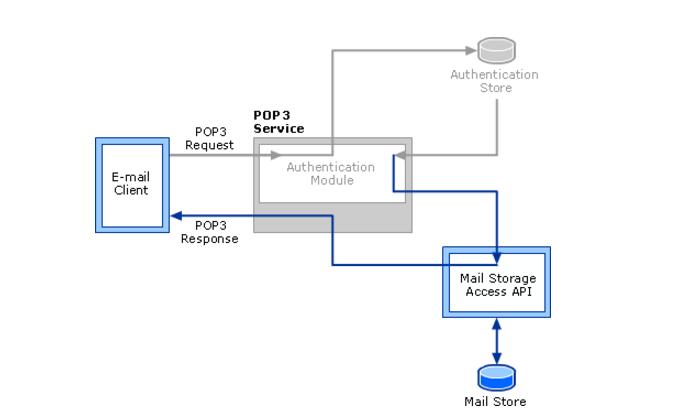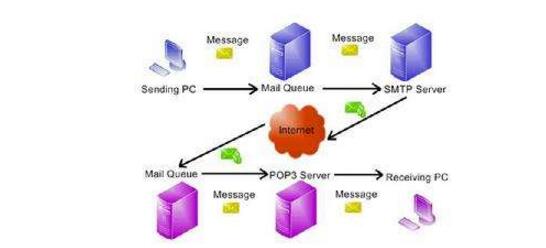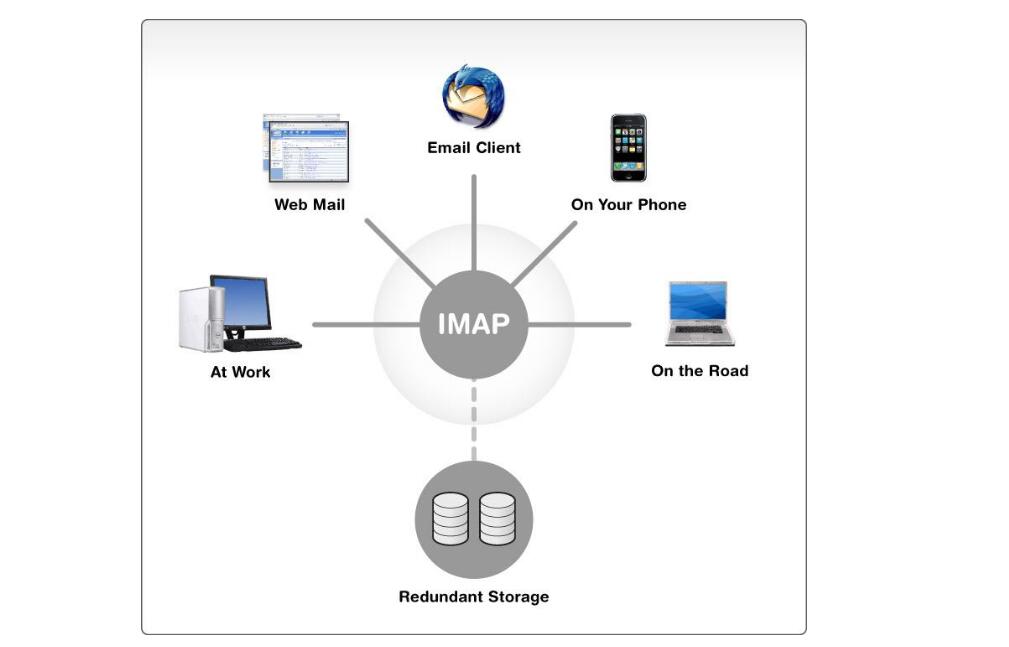POP3, the full name is "Post Office Protocol - Version 3", which is "Post Office Protocol Version 3." It is a member of the TCP/IP suite of protocols and is defined by RFC1939. This protocol is primarily intended to support the use of clients to remotely manage email on the server. The POP3 protocol that provides SSL encryption is called POP3S. The POP protocol supports "offline" mail processing. The specific process is: the mail is sent to the server, the email client calls the mail client program to connect to the server, and downloads all unread emails. This offline access mode is a store-and-forward service that sends mail from a mail server to a personal terminal machine, typically a PC or MAC. Once the mail is sent to the PC or MAC, the mail on the mail server will be deleted. However, most of the current POP3 mail servers can "download only mail, the server does not delete", which is the improved POP3 protocol. The server allows a mail client that conforms to POP3 (PostOfficeProtocol, Version 3 mail delivery protocol, version 3) to connect to the Imail server. These mail client software includes Outlook Express, Outlook, Netscape Messenger or Communicator, Eudora, Pegasus, NuPOP, Z-Mail, FoxMail, TheBat, Kmail, and Unixmail [2]. The POP3 client usually uses the "off-line" offline mode to access the mail server, periodically accesses the mail server, downloads the mail to the client's computer, and then disconnects from the server. In general, mail is temporarily stored on the server. When the client downloads the mail, they will be deleted by the server and will not be retained. For those who are always reading mail on the same computer, this method is very suitable. Another way, called "online" online, means that the mail client always stays connected to the server. The mail is kept on the server, the client does not download the mail to the client, and the user can read the mail kept on the server online. Users who often use different computers are suitable for this approach. The ImailPOP3 service can be used as a Windows NT service, run completely hidden or can run in some way. The service will always run even if you log out of the system. IMail also provides another access method, IMAP4 (InternetMessageAccessProtocolVersion4). The IMAP4 service provides both "online" and "offline" access methods. Logging On login defaults, the POP3 service uses the system account to log in to the system. You can change this login method: 1. In the Control Panel, start the Services applet. 2. Select the IMailPOP3 Server service and click Startup. 3. (Optional) Select the StartupType you want. 4. In LogOnAs, select the correct login account: IMailServerSystemAccount. If you have a mail host using the Windows NT user database as the Imail user database, then you need to use this account. AllowServicetoInteractwithDesktop. When using this account, any user will log into the system and there will be an Imail icon on the desktop. ThisAccount. In this way, if you do not use the Windows NT user database in your host, you can enter the user account you want; confirm that the account is a host administrator. If you have a mail host that utilizes an external database, verify that the account has access to an external database. Configuring the POP3 Server to configure the POP3 server to configure the pop3 server: 1. In IMailAdministrator, select "localhost" in the left panel. 2. Select the "Services" directory and click on the POP3.POP3 panel. 3. Enter the options described below to configure the POP3 service. 4. Click the Apply button to save the settings. 5. Stop the service, wait 5-10 seconds and restart the service. When you click the button Stop/Start, the changes to the settings are automatically saved. SMTP (Simple Mail Transfer Protocol) is a set of rules for transferring mail from source address to destination address, which controls the way the mail is transferred. The SMTP protocol is a TCP/IP protocol suite that helps each computer find the next destination when sending or forwarding a message. E-mail can be sent to the recipient's server through the server specified by the SMTP protocol, and the whole process takes only a few minutes. The SMTP server is a mail server that follows the SMTP protocol and is used to send or forward outgoing emails. It uses a reliable data transfer service provided by TCP to deliver mail messages from the sender's mail server to the recipient's mail server. Like most application layer protocols, SMTP also has two ends: the client executing on the sender's mail server and the server executing on the recipient's mail server. The client and server side of SMTP run on each mail server at the same time. When a mail server is sending mail messages to other mail servers, it is running as an SMTP client. Simple Mail Transfer Protocol (SMTP) is a text-based e-mail transfer protocol that is used in the Internet to exchange mail between mail servers. SMTP is an application layer service that can be adapted to various network systems. The SMTP commands and responses are based on text, in command line units, and the newline character is CR/LF. The response message is usually only one line, starting with a 3-digit code followed by a very short text description. SMTP has to go through three stages: establishing a connection, transmitting a message, and releasing a connection. Specifically: (1) Establish a TCP connection. (2) The client sends a HELO command to the server to identify the sender's own identity, and then the client sends a MAIL command. (3) The server responds with OK, indicating that it is ready to receive. (4) The client sends an RCPT command. (5) The server side indicates whether it is willing to receive mail for the recipient. (6) At the end of the negotiation, send the mail and send the input with the command DATA. (7) End the transmission and exit with the QUIT command. The SMTP server routes emails based on mail exchange (MX) records in DNS. When the email system sends an email, it locates the mail server based on the address suffix of the recipient. SMTP performs the functions of editing, collecting, and reading mail through the User Agent (UA); it delivers the mail to the destination through the Mail Transfer Agent (MTA). IMAP (Internet Mail Access Protocol) was formerly known as the InteracTIve Mail Access Protocol. IMAP is a mail acquisition protocol developed by Stanford University in 1986. Its main role is that mail clients (such as MS Outlook Express) can obtain mail information, download mail, etc. from the mail server through this protocol. The current authoritative definition is RFC3501. The IMAP protocol runs on top of the TCP/IP protocol and uses a port of 143. The main difference between it and the POP3 protocol is that the user does not have to download all the mails, and can directly operate the mail on the server through the client. Similar to the POP3 protocol, IMAP (Internet Message Access Protocol) is also a user-oriented mail collection service. The commonly used version is IMAP4. IMAP4 improves the deficiencies of POP3. Users can browse the letter header to decide whether to collect, delete and retrieve specific parts of the mail. You can also create or change folders or mailboxes on the server. In addition to supporting the offline operation mode of the POP3 protocol, it also supports online operations and disconnect operations. It provides users with the ability to selectively receive mail from a mail server, server-based information processing, and shared mailbox functionality. IMAP4's offline mode is different from POP3. It does not automatically delete the deleted mail on the mail server. Its online mode and disconnected mode also access the mail server as a "remote file server", which is more flexible and convenient. IMAP4 supports multiple mailboxes. These features of IMAP4 are ideal for users who operate mail between different computers or terminals (for example, you can operate the same mailbox on a mobile phone, PAD, or mail agent on a PC), and those who use multiple mailboxes at the same time. Both connection and disconnection modes of operation are supported. When using POP3, the client will only connect to the server for a period of time until the client downloads all new information and the client disconnects. In IMAP, as long as the user interface is active and downloading information content is needed, the client will always be connected to the server. For users with many or very large emails, IMAP4 mode can be used to achieve faster response times. Support multiple customers to connect to one mailbox at the same time. The POP3 protocol assumes that the current connection to the mailbox is the only connection. In contrast, the IMAP4 protocol allows multiple users to simultaneously access a mailbox while providing a mechanism for customers to be aware of the actions of other users currently connected to the mailbox. Support for accessing MIME parts and partial access in messages. Almost all Internet mail is transmitted in MIME format. MIME allows messages to contain a tree structure. The leaf nodes of this tree structure are all single content types, not leaf nodes are combinations of multiple block types. The IMAP4 protocol allows the client to obtain any independent MIME part and obtain some or all of the information. These mechanisms allow users to browse the content of a message or browse while browsing content without having to download an attachment. Support for retaining message status information on the server. The status of the message can be tracked by using the flag client defined in the IMAP4 protocol, such as whether the message was read, replied, or deleted. These IDs are stored on the server, so multiple customers accessing one mailbox at different times can be aware of what other users are doing. Support for accessing multiple mailboxes on the server. The IMAP4 client can create, rename, or delete mailboxes on the server (usually presented to users as a folder). Support for multiple mailboxes also allows the server to provide access to shared and public folders. Support server-side search. IMAP4 provides a mechanism for customers to enable customers to request servers to search for information that meets multiple criteria. Under this mechanism, the client does not need to download all the information in the mailbox to complete these searches. Support for a well-defined extension mechanism. Drawing on the experience of early Internet protocols, the extension of IMAP defines a clear mechanism. Many extensions to the original protocol have been proposed and widely used. Whether using POP3 or IMAP4 to get the message, the client uses the SMTP protocol to send. The mail client may be a POP client or an IMAP client, but will use SMTP. POP3 specifies how to connect a personal computer to the Internet's mail server and electronic protocols for downloading emails. It is the first offline protocol standard for Internet e-mail. POP3 allows users to store messages from the server to the local host (ie their own computer) and delete the messages stored on the mail server, while the POP3 server follows POP3. The protocol's receiving mail server is used to receive emails. The POP3 protocol allows the email client to download the mail on the server, but the client's operations (such as mobile mail, markup read, etc.) will not be fed back to the server, for example, the client will receive 3 emails in the mailbox and move. To other folders, these messages on the Mailbox server are not being moved at the same time. IMAP provides two-way communication between webmail and the e-mail client. The operation of the client is fed back to the server. The operation of the mail and the mail on the server also perform corresponding actions. At the same time, IMAP provides a convenient email download service like POP3, allowing users to read offline. The summary browsing feature provided by IMAP allows you to make a decision on whether to download after reading all the mail arrival time, subject, sender, size and other information. In addition, IMAP better supports access to new mail from multiple different devices at any time. SMTP It is a set of specifications for transferring mail from the source address to the destination address, which controls the way the mail is relayed. The SMTP protocol is part of the TCP/IP protocol suite, which helps each computer find the next destination when sending or forwarding a message. The SMTP server is the outgoing mail server that follows the SMTP protocol. SMTP authentication, in short, requires that you must log in to the SMTP server after providing the account name and password, which makes the spammers have no chance. The purpose of adding SMTP authentication is to protect users from spam. IMAP stands for Internet Mail Access Protocol, the interactive mail access protocol, which is one of the standard mail access protocols similar to POP3. The difference is that after IMAP is enabled, the emails you receive on the email client remain on the server, and the operations on the client are fed back to the server, such as deleting the email, marking the read, etc. on the server. The mail will also do the corresponding action. So whether you log in from the browser or the client software login mailbox, the emails and status are the same. The Mining Transformer,Mining Transformer,Electric Power Transformer,Electric Transformer SANON DOTRANSÂ Co., Ltd. , https://www.sntctransformer.com


I understand the difference and connection between POP3, SMTP and IMAP.
First, POP3 introduction